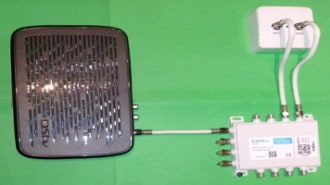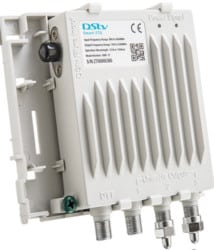
**My aim here is to take the sting out of connecting up your DStv decoder to a communal system. You have been working hard enough with the move to a new place. Let me help you to the point where you can relax a bit sooner.
** Corporate bodies will also benefit by this information, helping them to make better decisions concerning their DStv system.
*Here are the things you have to look out for, and the correct questions to ask:
- When buying or renting in a complex, ask the realtor or agent if there is a communal DStv system available.
- If yes, ask them if the system only accommodates older decoders, or is it possible to connect-up an Explora?
- If Explora’s are not catered for, who is the approved technician that can help you on the day you move in?
- If you are experiencing a problem, speak to your caretaker first. He will be able to give you more information of what to do, or who to contact.
What to do and who to approach:

- You will need to call the technician to make an appointment and get a costing for the upgrade.
- You would ideally want to just plug the cable from your decoder into the wall socket, and have it work immediately.
- This however is very seldom the case.
- If there are two female connection points available in your unit, then you can connect your decoder like in the picture above. The two wall outputs get connected to the V/L and the H/L on the Smartswitch.
- There are newer complexes where the developer was prepared to spend the money and install the most advanced systems, that would give tenants the plug and play benefit. (Without needing a Smart-switch).
- You also get progressive Corporate Bodies where the Trustees manage the funds well and spend it wisely on good DStv systems, that benefit the owners and tenants.
How to connect when there is a fibre system installed:
- Nowadays it is more common to find a strange looking connector box in your unit that you are moving into.
- There are not too many types. If you look at it closely the word fibre will be on the front.
- Some types will require that you add a “Smartswitch” to it and others don’t. If it has four Universal or Quatro outputs a smartswitch is required.
- If the outputs are marked SatCr or Unicable, you can connect them directly to your Explora decoders.
- The diagram below gives you a clear idea of how to connect your decoders to it.
- Extra view is also possible with all these connection devices. No heartbeat cables are required, just one cable from the converter box to each decoder.

Important DStv information for owners, tenants & Body Corporates:
*Trustees should study this info carefully when deciding to upgrade their systems, to be more up to date, and user-friendly.
*Lots of money is spent by body corporates and tenants in order to get their decoders to work when they move in. Tenants mostly get the cheapest guy to come and hook them up, who usually disconnects other users in the process. The trustees or caretaker then have to get an approved installer out to rectify things , at uncalled for costs.
HOW DO THESE SYSTEMS WORK?
**The following is a description of the different types of communal systems, what they consists of, and what each component does. This will help tenants better understand how to link into the system, and get the best results.
TYPE 1. VERY BASIC DSTV SYSTEM:
- This will have a dish equipped with anything from a 2 port , 4 port, or an 8 port Universal LNB with a single cable to each unit.
- This will limit the inhabitant to the use of only an older SD Decoder or a single HD decoder without recording facility.
- Will have high band available for extended HD channels.
TYPE 2. OLDER DSTV SYSTEM WITH MULTI-SWITCH:
- The system has a Twin LNB on the dish.
- It is then wired with two cables to the box that contains the multi-switches, giving only Universal signals.
- These older multi-switches can then deliver only limited signals to the apartments, with no Explora signals and only Low-band HD channels.
- The high-band (DStv second Satellite) is not available for the extended HD channels and future channels.
- HD-PVR decoders will also not be able to record all channels.
- An approved technician can connect a smart-switch inside the communal box for an individual tenant, to give them a SatCr signal required for an Explora decoder, with some HD channels in SD format.
- This system does not comply to the DStv standards.
TYPE 3.OLDER MORE ADVANCED DSTV SYSTEMS:
- Here we have a dish equipped with a Quatro LNB.
- It is then wired with four cables to the the box containing the multi-switches, delivering yet only Universal signals for older decoders.
- Here at least the high-band is available for any HD decoders.
- Once again an accredited technician can do his magic to give signal to Explora decoders with full HD channels, by installing a Smart switch in the communal box.
- The Problem however is that the space in the communal box is limited, so it starts to get messy in there.
- You do not want any tenant to go in there and accidentally disconnect others, when retrieving his smart-switch.
- This system does not comply to the DStv standards because the tenant cannot install a Smart-switch inside his unit for extra-view.
TYPE 4. LATEST QUATRO / UNICABLE DSTV SYSTEM:
- This is the most popular system currently used, for many reasons:
- It incorporates Low-Band and High-Band. (Both DStv satellites).
- It supplies Universal signals to older DStv decoders, SABC decoders, OVHD decoders, as well as Free to Air decoders. (FTA).
- The latest Exploras and single HD decoders are catered for.
- These Multi-switches are smart by sensing the type of signal required by the decoder, and then supplying the appropriate signal.
- This means that a new tenant or owner can just connect whatever decoder they have and it will work immediately. No technicians are required and nobody ever needs to go and tamper on the system connections. This alone saves a lot of money in the long run.
- For all you get, this option is surely the best to take and good value for money.
- We have to accept that the days are long gone where you could install a Tv system for R30,000.oo in a apartment building. People are demanding high quality standards of services regarding their domestic internet, telephony and entertainment Tv.
- Investors are also starting to be wise, and rather buying into a complex that is well equipped, compared to the ones that only have the bare minimum.
TYPE 5. SINGLE CABLE SYSTEMS:
- In earlier years many older buildings were fitted with “Single Cable” systems, because their conduits were too small to fit more cables. ( This is the type that needs decoder frequency programming) These systems have now reached their maximum capacity and will need to be replaced. They are also not approved my DStv.
TYPE 6. FIBER-OPTIC IS NOW THE BUZZWORD IN DSTV SYSTEMS:
**With this type of system, there are a few factors that we should keep in mind. Fiber is not always the best option. The type of building lay-out has to be taken into account. Here are the main advantages:
- Very Low signal loss over many kilometers.
- Having no attraction for Lightning, making it is safer for all the equipment connected to it down the line.
- It has capacity for a lot more bandwidth. (Can carry more Data) at higher speeds.
- Longer lifespan.
** The disadvantages of Fiber Optic cables:
- The cable are more fragile and not as rugged as copper.
- Fiber cable is very sensitive to splice (Join).
- Not only is Fiber cables expensive to manufacture, you also need specialists to install it, driving up the cost.
- The distribution equipment is still not developed enough and the industry needs some tweaking in order for it to reach the a point of maximum effectiveness.

**With rapid advancement in this technology, it as now possible to run different services in one fibre cable.
** Currently the cost is making it only viable for distributing DStv signal in very large Estates. (2000+ homes) * DStv has now implemented a smaller type system that makes fibre in smaller complexes more cost effective via a subsidized method.
TYPE 7. A HYBRID FIBER & COPPER DSTV SYSTEM:
- Installing the cable from the main distribution point to the different blocks of apartments in a complex, mostly requires very long cables, as well as a series of line- amplifiers using copper cables. Sometimes the buildings conduits are too small for five cables to go through. This is where it may be ideal to distribute all five signals through a single fiber cable to the points where the signal can be converted to RF to be distributed further by copper cables.
- It is just a matter of using technology to get past certain obstructions.
- This also helps to keep the cost down.
TYPE 8. ADDING Dvb-T2 TO THE DSTV SYSTEM:
- We always have to keep in mind the inhabitants that cannot afford DStv, but want to get the free channels from the Terrestrial service.
- A lot of property developers do not consider these people and install DStv only in their complexes, which is not fair at all.
- The cost of adding DvbT / terrestrial tv, to the system is so very little, that it should not be ignored.
- Any satellite installer worth his salt, should add this to all their DStv installations.
- SABC and Etv, currently have various free channels available on this platform, with many Tv manufacturers now having built-in DvbT tuners in many Tv models.
- M-Net has a very cheap pay Tv channel listing on it’s platform (Go-Tv) that would surely attract many viewers. The set top boxes are also cheap. A tenant can just connect his Go-Tv box to the Tv port on the wall socket, to receive a moderate amount of channels.
Conclusion:
When Property Developers and Corporate bodies plan and do it the right way, they will surely benefit by selling their units faster and having much less complaints from buyers and tenants. There will be no reason for tenants to want to tamper with the communal box. This makes the management of the complex so much easier.
** Communal systems can be very daunting, so it is always advisable to contact your local Accredited DStv Installer to advise or remedy the problem for you. A list of installers are available on: DStv.co.za under self service, and find an installer.
